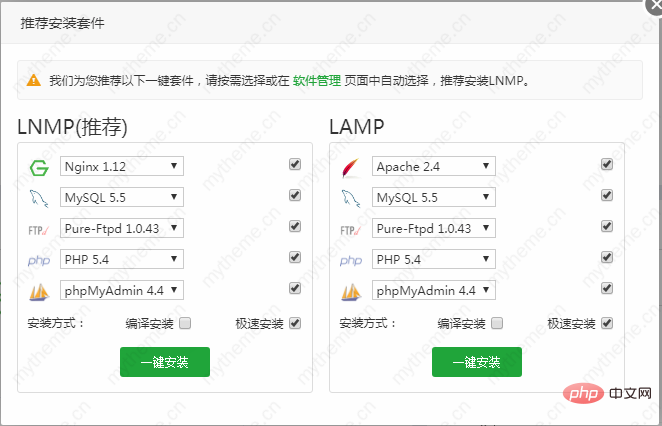
The following tutorial column ofPagoda Panelwill introduce to you the differences and choices of using Pagoda Panel LNMP and LAMP environment kits. I hope it will be helpful to friends in need!
1. After the Pagoda installation is completed, open the panel address on the browser and log in to the panel. The panel will automatically recommend you to install the environment package. There are two options here. The first is the LNMP package, and the second is LAMP kit (as shown below):

The main difference between LNMP and LAMP environments is the web server. One kit uses the Apache server and the other uses the Nginx server.
If you don’t understand the difference between the two, please use the official default recommended installation (LNMP suite) of Pagoda. The installation method is chosen according to your actual situation. If the current environment is a production environment, please use ( Compile and install) to ensure the stability of later program operation. (Extremely fast installation) is mainly used for experience and testing. Please avoid using (extremely fast installation) in official situations. If you do not need these packages, you can also select "Software" in the function bar on the left side of the panel. Manage" and select the installer in the current list.
2. After selecting one-click installation, the number of tasks will be automatically displayed in the upper left corner of the panel. Click to enter the task list. The current interface will display the installation progress of the program, or the progress of program execution, etc. After waiting for a while, check the information in the task list to see if it is completed. (As shown below):
3, the difference between LNMP and LAMP environments
Nginx features
The full name of nmp is linux nginx mysql php
Nginx has stable performance, rich functions, simple operation and maintenance, fast processing of static files and consumes very few system resources.
3-1. Compared with Apache, using Nginx as a web server: uses fewer resources, supports more concurrent connections, and is more efficient.
3-2. As a load balancing server: Nginx can not only directly support Rails and PHP internally, but also support external services as an HTTP proxy server. Nginx is written in C, and its system resource overhead and CPU usage efficiency are much better than Perlbal.
3-3. As a mail proxy server: Nginx is also a very excellent mail proxy server (one of the earliest purposes of developing this product is to serve as a mail proxy server).
3-4. The reverse proxy can redirect requests to clusters for different purposes according to the URL. For example, picture requests are redirected to the picture server cluster; video requests are redirected to the video server cluster. nginx is a lightweight web server/reverse proxy server/email proxy server. The installation is very simple and the configuration file is also very concise (it also supports perl syntax). Nginx supports smooth loading of new configurations and can also perform software version upgrades without interrupting service.
Characteristics of Apache
The full name of lamp is linux apache mysql php
3-5. Apache is the core Web Server of the LAMP architecture. It is open source, stable, and rich in modules. Advantages of Apache. However, the disadvantages of Apache are that it is a bit bloated, has high memory and CPU overhead, and has a loss in performance. It is not as efficient as some lightweight web servers (such as Nginx, Tengine, etc.), and lightweight web servers are not as responsive to static files. Said much higher than Apache server.
3-6. Apache as a Web Server is the best choice for loading PHP. If the traffic is large, Nginx can be used to load non-PHP web requests. Nginx is a high-performance HTTP and reverse proxy server. Nginx is known for its stability, rich feature set, sample configuration files, and low system resource consumption. Nginx now supports PHP and FastCGI, and also supports load balancing and fault tolerance. It can be used with Apache and is the first choice for lightweight HTTP servers.
3-7. There are many solutions for web server caching. Apache provides its own caching module, or you can use an additional Squid module for caching. Both methods can effectively improve Apache's access response capabilities. Squid Cache is a web cache server that supports efficient caching and can be used as a front cache server for the web server to cache related requests to improve the speed of the web server. Put Squid in front of Apache to cache dynamic content generated by the web server, and the web application only needs to set the page validity time appropriately. If the access volume is huge, you can consider using memcache as a distributed cache.
3-8. To accelerate PHP, you can use the eAccelerator accelerator. eAccelerator is a free and open source PHP accelerator. It will optimize dynamic content caching, improve PHP script caching performance, and almost completely eliminate the overhead on the server when PHP scripts are compiled. It can also optimize scripts to speed up their execution. The efficiency of PHP program code execution can be increased by 1-10 times.
As for which one is better to install?
If you want to save memory, lnmp is the best choice, but it seems to be unstable. Sometimes it is more common.
It is good to use lnmp for static purposes.
There is a lot of dynamic content. If so, lamp is still the most stable
The above is the detailed content of How to choose Pagoda Panel LNMP and LAMP environment kit. For more information, please follow other related articles on the PHP Chinese website!




